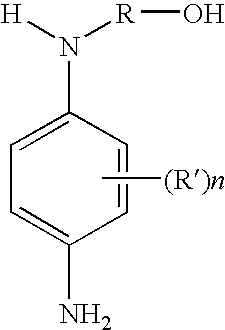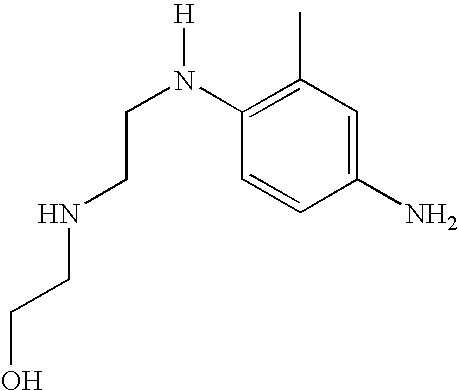Ortho-and/or meta-substituted N-alkylhydroxylated secondary para-phenylenediamine compounds, compositions for dyeing keratin fibers comprising such compounds, and processes of dyeing therewith
a technology of nalkyl hydroxylated phenylenediamine and paraphenylenediamine, which is applied in the preparation of amino-hyroxy compounds, nitro/nitroso dyes, cosmetics, etc., to achieve good toxicological profile and good resistance
- Summary
- Abstract
- Description
- Claims
- Application Information
AI Technical Summary
Benefits of technology
Problems solved by technology
Method used
Image
Examples
synthesis examples
Example 1
Synthesis of N-1-(2-aminoethyl)-2-methoxymethylbenzene-1,4-diamine dihydrochloride (4)
[0078]
Step 1: Preparation of 2-methoxymethyl-4-nitrophenol (1)
[0079]18.7 g (0.1 mol) of 2-chloromethyl-4-nitrophenol and 50 ml of pure methanol were mixed together and refluxed for 2 hours 30 minutes. 37 ml of sodium methoxide (0.2 mol, 5.4 N solution in MeOH) were added and the mixture was refluxed for another 30 minutes. The resulting mixture was cooled in an ice bath and diluted with 350 ml of water, and the insoluble matter formed was filtered off. The filtrate was acidified with acetic acid (10 ml). The crystalline product was filtered off by suction, reslurried in ice-cold water and then dried over P2O5 at 40° C. 11.4 g of crude products were isolated and then recrystallized from 15 ml of isopropyl acetate to give 7.5 g of expected product.
Step 2: Preparation of 1-benzyloxy-2-methoxymethyl-4-nitrobenzene (2)
[0080]18.3 g of 2-methoxymethyl-4-nitrophenol (1) (0.1 mol), 8.3 g (0.06 mol)...
example 2
Synthesis of 2-[2-(4-amino-2-methylphenylamino)ethylamino]ethanol dihydrochloride (6)
[0085]
Step 1: Synthesis of 2-[2-(4-nitro-2-methylphenylamino)ethylamino]ethanol (5)
[0086]2 g of 4-fluoro-3-methyl nitrobenzene, 1.61 g of 2-(2-aminoethylamino)ethanol and 2.14 g of K2CO3 were added to a solution of 20 ml of N-methylpyrrolidinone. The reaction medium was heated at 60° C. for 7 hours and, after cooling to room temperature, was then poured into a water and ice mixture. The yellow precipitate formed was filtered off, reslurried in water and then dried over P2O5. 2.4 g of 2-[2-(4-nitro-2-methylphenylamino)ethylamino]ethanol (5) were obtained.
Step 2: Synthesis of 2-[2-(4-amino-2-methylphenylamino)ethylamino]ethanol dihydrochloride (6)
[0087]The 2-[2-(4-nitro-2-methylphenylamino)ethylamino]ethanol (5) obtained above was reduced with a boiling zinc / ammonium chloride / water / ethanol mixture. The corresponding amine was isolated in dihydrochloride form.
example 3
Synthesis of 2-[2-(4-amino-3-methylphenylamino)ethylamino]ethanol dihydrochloride (8)
[0089]
Step 1: Synthesis of 2-[2-(4-nitro-3-methylphenylamino)ethylamino]ethanol (7)
[0090]2 g of 4-fluoro-2-methyl-nitrobenzene, 1.61 g of 2-(2-aminoethylamino)ethanol and 2.14 g of K2CO3 were added to a solution of 20 ml of N-methylpyrrolidinone. The reaction medium was heated at 60° C. for 7 hours and, after cooling to room temperature, was then poured into a water and ice mixture. The yellow precipitate formed was filtered off, reslurried in water and then dried over P2O5. 1.3 g of 2-[2-(4-nitro-3-methylphenylamino)ethylamino]ethanol (7) were obtained.
Step 2: Synthesis of 2-[2-(4-amino-3-methylphenylamino)ethylamino]ethanol dihydrochloride (8)
[0091]The 2-[2-(4-nitro-3-methylphenylamino)ethylamino]ethanol (7) obtained above was reduced with a boiling zinc / ammonium chloride / water / ethanol mixture. The corresponding amine was isolated in dihydrochloride form.
PUM
| Property | Measurement | Unit |
|---|---|---|
| melting point | aaaaa | aaaaa |
| temperature | aaaaa | aaaaa |
| temperature | aaaaa | aaaaa |
Abstract
Description
Claims
Application Information
 Login to View More
Login to View More - R&D
- Intellectual Property
- Life Sciences
- Materials
- Tech Scout
- Unparalleled Data Quality
- Higher Quality Content
- 60% Fewer Hallucinations
Browse by: Latest US Patents, China's latest patents, Technical Efficacy Thesaurus, Application Domain, Technology Topic, Popular Technical Reports.
© 2025 PatSnap. All rights reserved.Legal|Privacy policy|Modern Slavery Act Transparency Statement|Sitemap|About US| Contact US: help@patsnap.com



